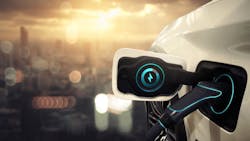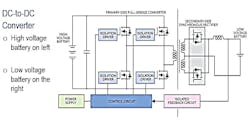Perhaps the most important factor to consider when working on cars, whether that be electric vehicles (EV) or internal combustion engine (ICE), is technician safety. As many know and can attest to, technician jobs come with a level of risk involved.
According to the Bureau of Labor Statistics, around 13,150 technicians reported non-fatal workplace injuries and illnesses which sometimes led to time away from work. Despite the popularity of EVs, there is still much to be learned about how to safely work on them. This can create hesitation and worry in technicians.
Fortunately, NAPA has worked tirelessly to educate technicians and break down some of the stigma surround EV repair.
Our team sat down with two representatives from NAPA, technician Jake Sorensen and Susan Starnes, VP, emerging markets, to learn more about the ways NAPA has responded to the upsurge of EVs.
Out with the old, in with the new
One of the first steps to clear the fog around EV repair is to teach technicians that the old way of doing things must be rewritten.
"By far the most important factor in safety when working on hybrid or EV vehicles is training 100 percent," says Sorensen. "You just can't have the mentality of, if [you] can see the parts, [you] can pull it apart and figure it out, [but]... you really need training to understand how to properly test them and make sure that things have been turned off and [its] safe to act."
These training must be extensive, covering things like proper tools, safety equipment, and the unique circumstances that could potentially arise while working with electric or hybrid vehicles.
"Training is certainly important and it is also important to keep in mind that there are specialized tools that need to be used," says Starnes. "Whether that be protective equipment [like] insulated gloves or insulated tools. These are all things that are equally important to have in your workshop to make sure you're able to safely work on the vehicles."
From the technician's perspective
No one is more affected by the arrival of EVs in the repair shop than the technicians that work on them. It can be difficult to find resources or trainings that cater to every aspect of EV/hybrid servicing.
"In the early days, it was really difficult to find the training needed," says Sorensen. "It was difficult to find the proper tooling. It was difficult to find the parts we needed. All of that has gotten substantially easier... in large part due to companies like NAPA that have programs... where they're focusing on offering us those resources that we need."
NAPA offers EV training and certification that provide technicians with hands-on experience working with both hybrid and electric vehicles. All classes are taught by ASE certified training specialists and are 100 percent technical.
When technicians go through NAPA's training, they come out equipped with the knowledge and experience needed to comfortably work on EVs. Gone are the days where a repair shop refers all electric or hybrid vehicles to a single technician. NAPA's trainings aim to equip all technicians with the knowledge and comfortability they need to perform their jobs well.
"As America's largest network of parts and care, we feel we are well-positioned to help the small businesses and workshops as we move into the future," Starnes shares. "We feel it's our responsibility and we are excited about it."
Levelling the playing field
Location plays a significant factor in the availability of training for technicians and autobody shops. Small businesses located outside of larger cities or places where the majority of new EVs are being driven might have a harder time finding that invaluable hands-on experience that NAPA recommends.
"The shops that are involved in the training and are progressive in new technology and trying to be at the forefront of all of this are gonna be just fine," Sorensen says. "It's the shops that are already struggling to keep up with technology that are really going to suffer."
While the technology surrounding electric and hybrid vehicles can be something to marvel at, some technicians and shop owners are not nearly as impressed or eager with this new trend in the industry. Sorensen believes that in order to move safely and efficiently through this changing field, technicians need to be able to hang their opinions up at the door. These cars, whether you love or hate them, are coming out and will inevitably need to be repaired.
NexDrive and NAPA's approach
As part of a global organization, NAPA has been able to see the implementation of EVs in parts of Canada and Europe and leverage from those learnings.
In 2020, NAPA started their NexDrive powered by NAPA program out of the Netherlands and expanded into Canada, parts of Europe, and now the U.S. The goal of the program is to help shop owners and technicians prepare for the emergence of EVs and to equip them with the knowledge on how to safely service them.
The program focuses on four pillars: parts and products, the NAPA network, the user's automotive repair shop, and marketing.
"[NexDrive] is really focused on preparing workshops to safely work on, maintain, and repair electric and hybrid vehicles," Starnes explains. "It includes everything from having the right products to marketing and most critically, the training that we keep talking about."
In addition to their training programs, NAPA has a line of fully insulated tools, coming out at about 133 tools and nine tool sets. When looking for tools in the aftermarket, it's important that they're fully insulated and are rated to 1,000V.
As for the trajectory of the auto repair industry, it's hard to say exactly where things will go in, but as for right now it looks like the future is electric.



